MERCEDES-BENZ E-CLASS ESTATE 2012 Owners Manual
Manufacturer: MERCEDES-BENZ, Model Year: 2012, Model line: E-CLASS ESTATE, Model: MERCEDES-BENZ E-CLASS ESTATE 2012Pages: 457, PDF Size: 11.62 MB
Page 391 of 457
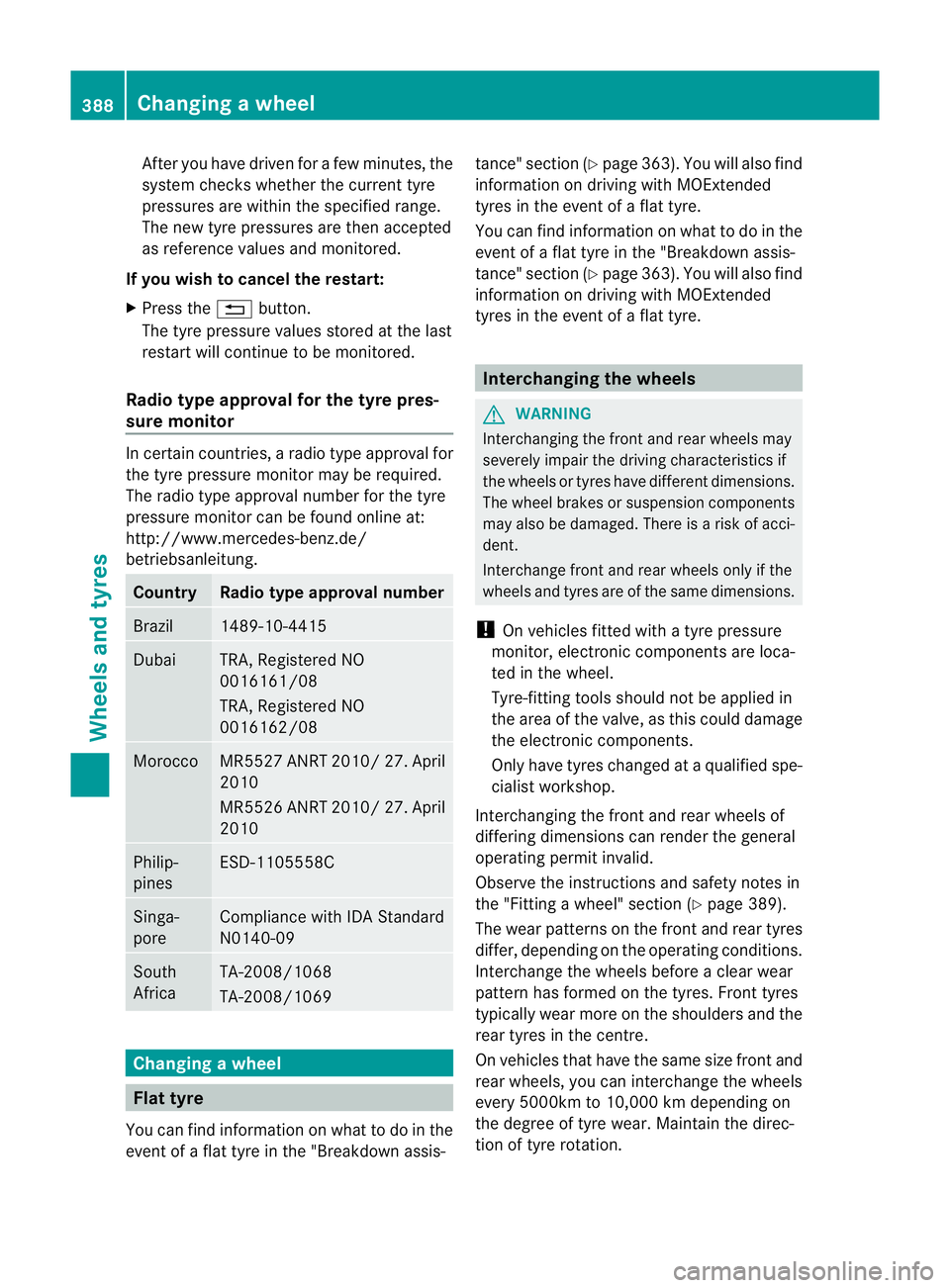
After you have driven for a few minutes, the
system checks whether the current tyre
pressures are withi
nthe specified range.
The new tyre pressures are then accepted
as reference values and monitored.
If you wish to cancel the restart:
X Press the %button.
The tyre pressure values stored at the last
restart will continue to be monitored.
Radio type approval for the tyre pres-
sure monitor In certain countries, a radio type approval for
the tyre pressure monitor may be required.
The radio type approval number for the tyre
pressure monitor can be found online at:
http://www.mercedes-benz.de/
betriebsanleitung. Country Radio type approval number
Brazil 1489-10-4415
Dubai TRA, Registered NO
0016161/08
TRA, Registered NO
0016162/08
Morocco MR5527 ANRT 2010/ 27. April
2010
MR5526 ANRT 2010/ 27. April
2010
Philip-
pines ESD-1105558C
Singa-
pore Compliance with IDA Standard
N0140-09
South
Africa TA-2008/1068
TA-2008/1069
Changing
awheel Flat tyre
You can find information on wha tto do in the
event of a flat tyre in the "Breakdown assis- tance" section (Y
page 363). You will also find
information on driving with MOExtended
tyres in the event of a flat tyre.
You can find information on what to do in the
event of a flat tyre in the "Breakdown assis-
tance" section (Y page 363). You will also find
information on driving with MOExtended
tyres in the event of a flat tyre. Interchanging the wheels
G
WARNING
Interchanging the front and rear wheels may
severely impair the driving characteristics if
the wheels or tyres have different dimensions.
The wheel brakes or suspension components
may also be damaged. There is a risk of acci-
dent.
Interchange front and rear wheels only if the
wheels and tyres are of the same dimensions.
! On vehicles fitted with a tyre pressure
monitor, electronic components are loca-
ted in the wheel.
Tyre-fitting tools should not be applied in
the area of the valve, as this could damage
the electronic components.
Only have tyres changed at a qualified spe-
cialist workshop.
Interchanging the front and rear wheels of
differing dimensions can render the general
operating permit invalid.
Observe the instructions and safety notes in
the "Fitting a wheel" section (Y page 389).
The wear patterns on the front and rear tyres
differ, depending on the operating conditions.
Interchange the wheels before a clear wear
pattern has formed on the tyres. Front tyres
typically wear more on the shoulders and the
rear tyres in the centre.
On vehicles that have the same size front and
rear wheels, you can interchange the wheels
every 5000km to 10,000 km depending on
the degree of tyre wear. Maintain the direc-
tion of tyre rotation. 388
Changing
awheelWheels and tyres
Page 392 of 457
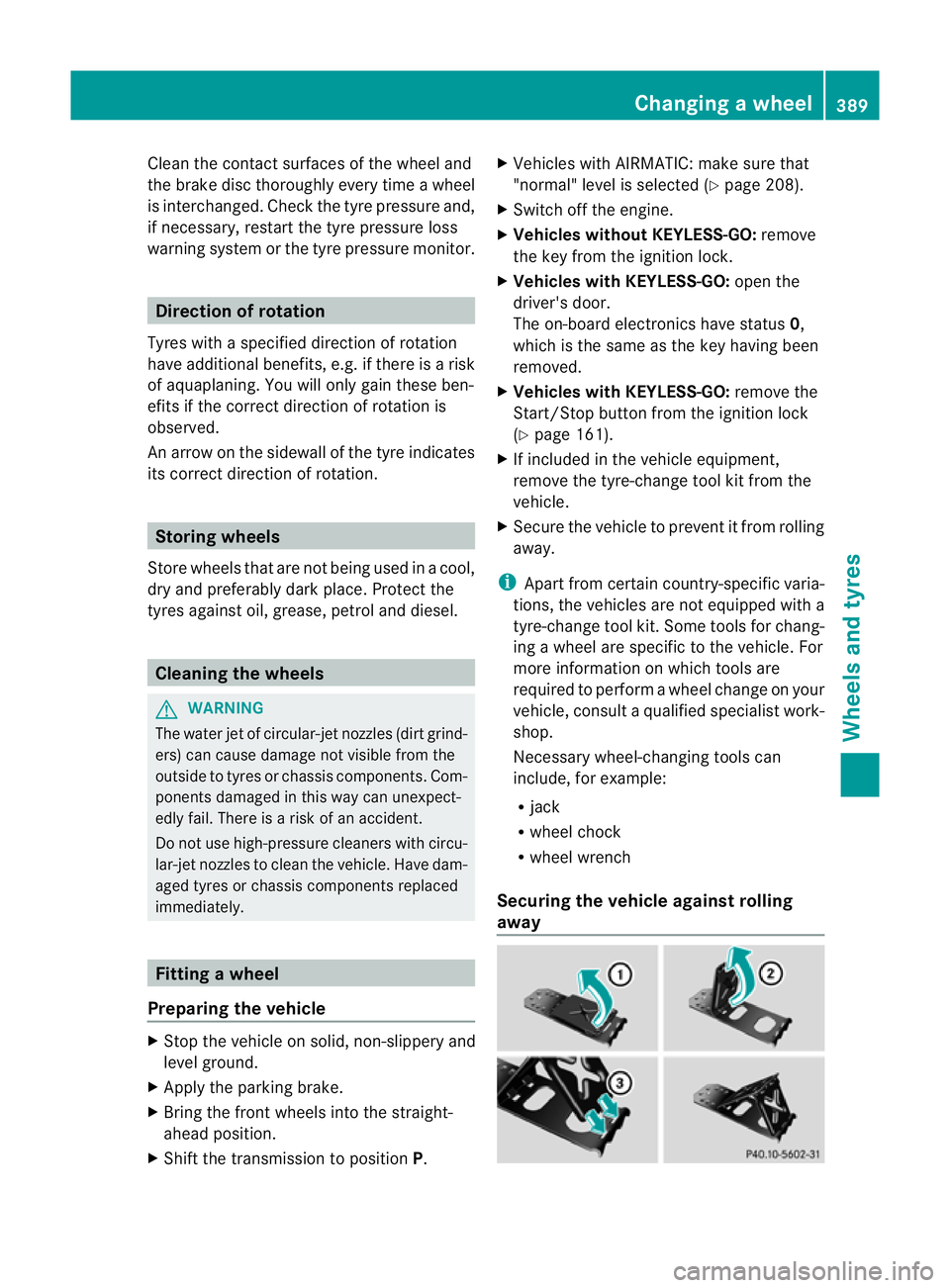
Clean the contact surface
softhe wheel and
the brake disc thoroughly every time a wheel
is interchanged. Check the tyre pressure and,
if necessary, restart the tyre pressure loss
warning system or the tyre pressure monitor. Direction of rotation
Tyres with a specified direction of rotation
have additional benefits, e.g. if there is a risk
of aquaplaning. You will only gain these ben-
efits if the correct direction of rotation is
observed.
An arrow on the sidewall of the tyre indicates
its correct direction of rotation. Storing wheels
Store wheels that are not being used in a cool,
dry and preferably dark place. Protect the
tyres against oil, grease, petrol and diesel. Cleaning the wheels
G
WARNING
The water jet of circular-jet nozzles (dirt grind-
ers) can cause damage not visible from the
outside to tyres or chassis components. Com-
ponents damaged in this way can unexpect-
edly fail. There is a risk of an accident.
Do not use high-pressure cleaners with circu-
lar-jet nozzles to clean the vehicle. Have dam-
aged tyres or chassis components replaced
immediately. Fitting
awheel
Preparing the vehicle X
Stop the vehicle on solid, non-slippery and
level ground.
X Apply the parking brake.
X Bring the front wheels into the straight-
ahead position.
X Shift the transmission to position P.X
Vehicles with AIRMATIC :make sure that
"normal" level is selected (Y page 208).
X Switch off the engine.
X Vehicles without KEYLESS-GO: remove
the key from the ignition lock.
X Vehicles with KEYLESS-GO: open the
driver's door.
The on-board electronics have status 0,
which is the same as the key having been
removed.
X Vehicles with KEYLESS-GO: remove the
Start/Stop button from the ignition lock
(Y page 161).
X If included in the vehicle equipment,
remove the tyre-change tool kit from the
vehicle.
X Secure the vehicle to preven titfrom rolling
away.
i Apart from certain country-specific varia-
tions, the vehicles are not equipped with a
tyre-change tool kit. Some tools for chang-
ing a wheel are specific to the vehicle. For
more information on which tools are
required to perform a wheel change on your
vehicle, consult a qualified specialist work-
shop.
Necessary wheel-changing tools can
include, for example:
R jack
R wheel chock
R wheel wrench
Securing the vehicle agains trolling
away Changing
awheel
389Wheels and tyres Z
Page 393 of 457
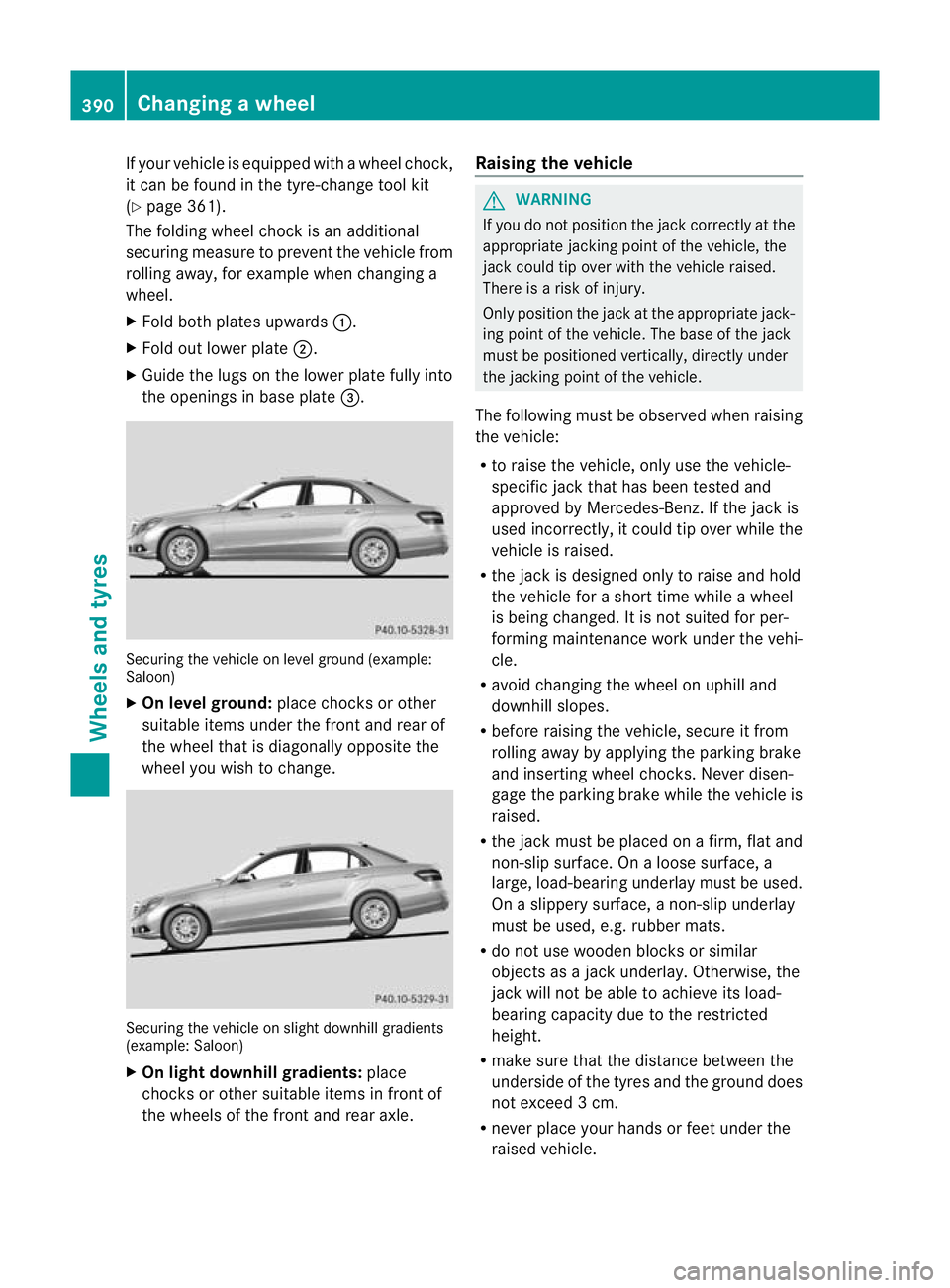
If yourv
ehicle is equipped with a wheel chock,
it can be found in the tyre-change tool kit
(Y page 361).
The folding wheel choc kis an additional
securing measure to prevent the vehicle from
rolling away, for example when changing a
wheel.
X Fold both plates upwards :.
X Fold out lower plate ;.
X Guide the lugs on the lower plate fully into
the openings in base plate =.Securing the vehicle on level ground (example:
Saloon)
X
On level ground: place chocks or other
suitable items under the front and rear of
the wheel that is diagonally opposite the
wheel you wish to change. Securing the vehicle on slight downhill gradients
(example: Saloon)
X On light downhill gradients: place
chocks or other suitable items in front of
the wheels of the front and rear axle. Raising the vehicle G
WARNING
If you do not position the jack correctly at the
appropriate jacking point of the vehicle, the
jack could tip over with the vehicle raised.
There is a risk of injury.
Only position the jack at the appropriate jack-
ing point of the vehicle. The base of the jack
must be positioned vertically, directly under
the jacking point of the vehicle.
The following must be observed when raising
the vehicle:
R to raise the vehicle, only use the vehicle-
specific jack that has been tested and
approved by Mercedes-Benz. If the jack is
used incorrectly, it could tip over while the
vehicle is raised.
R the jack is designed only to raise and hold
the vehicle for a short time while a wheel
is being changed. It is not suited for per-
forming maintenance work under the vehi-
cle.
R avoid changing the wheel on uphill and
downhill slopes.
R before raising the vehicle, secure it from
rolling away by applying the parking brake
and inserting wheel chocks. Never disen-
gage the parking brake while the vehicle is
raised.
R the jack must be placed on a firm, flat and
non-slip surface. On a loose surface, a
large, load-bearing underlay must be used.
On a slippery surface, a non-slip underlay
must be used, e.g. rubber mats.
R do not use wooden blocks or similar
objects as a jack underlay.O therwise, the
jac kw ill not be able to achieve its load-
bearing capacity due to the restricted
height.
R make sure that the distance between the
underside of the tyres and the ground does
not exceed 3 cm.
R never place your hands or feet under the
raised vehicle. 390
Changing
awheelWheels and tyres
Page 394 of 457
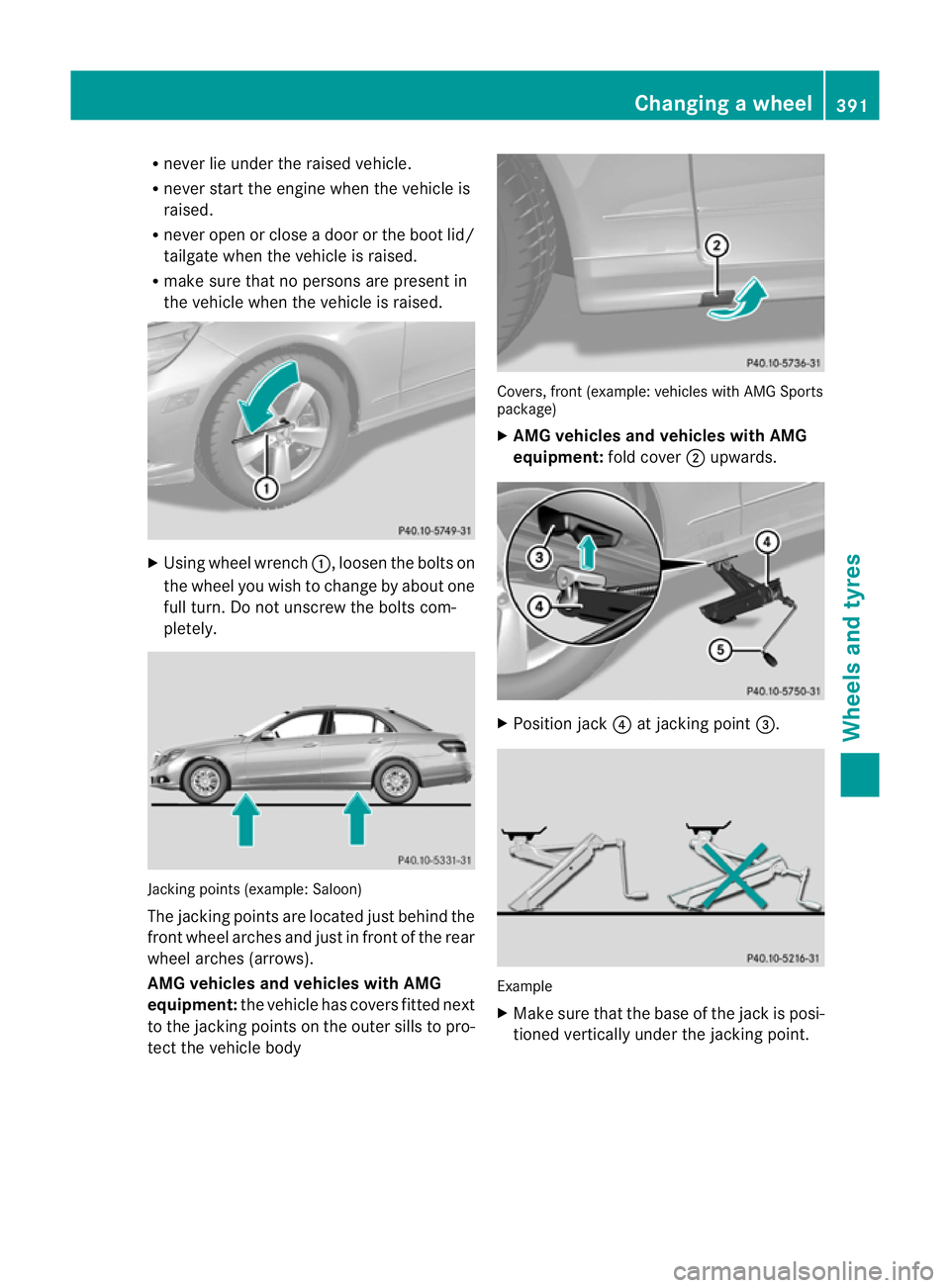
R
neve rlie under the raised vehicle.
R never start the engine when the vehicle is
raised.
R never open or close a door or the boot lid/
tailgate when the vehicle is raised.
R make sure that no persons are present in
the vehicle when the vehicle is raised. X
Using wheel wrench :, loosen the bolts on
the wheel you wish to change by about one
full turn. Do not unscrew the bolts com-
pletely. Jacking points (example: Saloon)
The jacking points are located just behind the
front wheel arches and just in front of the rear
wheel arches (arrows).
AMG vehicles and vehicles with AMG
equipment: the vehicle has covers fitted next
to the jacking points on the outer sills to pro-
tec tthe vehicle body Covers, front (example: vehicles with AMG Sports
package)
X
AMG vehicles and vehicles with AMG
equipment: fold cover;upwards. X
Position jack ?at jacking point =. Example
X
Make sure that the base of the jack is posi-
tioned vertically under the jacking point. Changing
awheel
391Wheels and tyres Z
Page 395 of 457
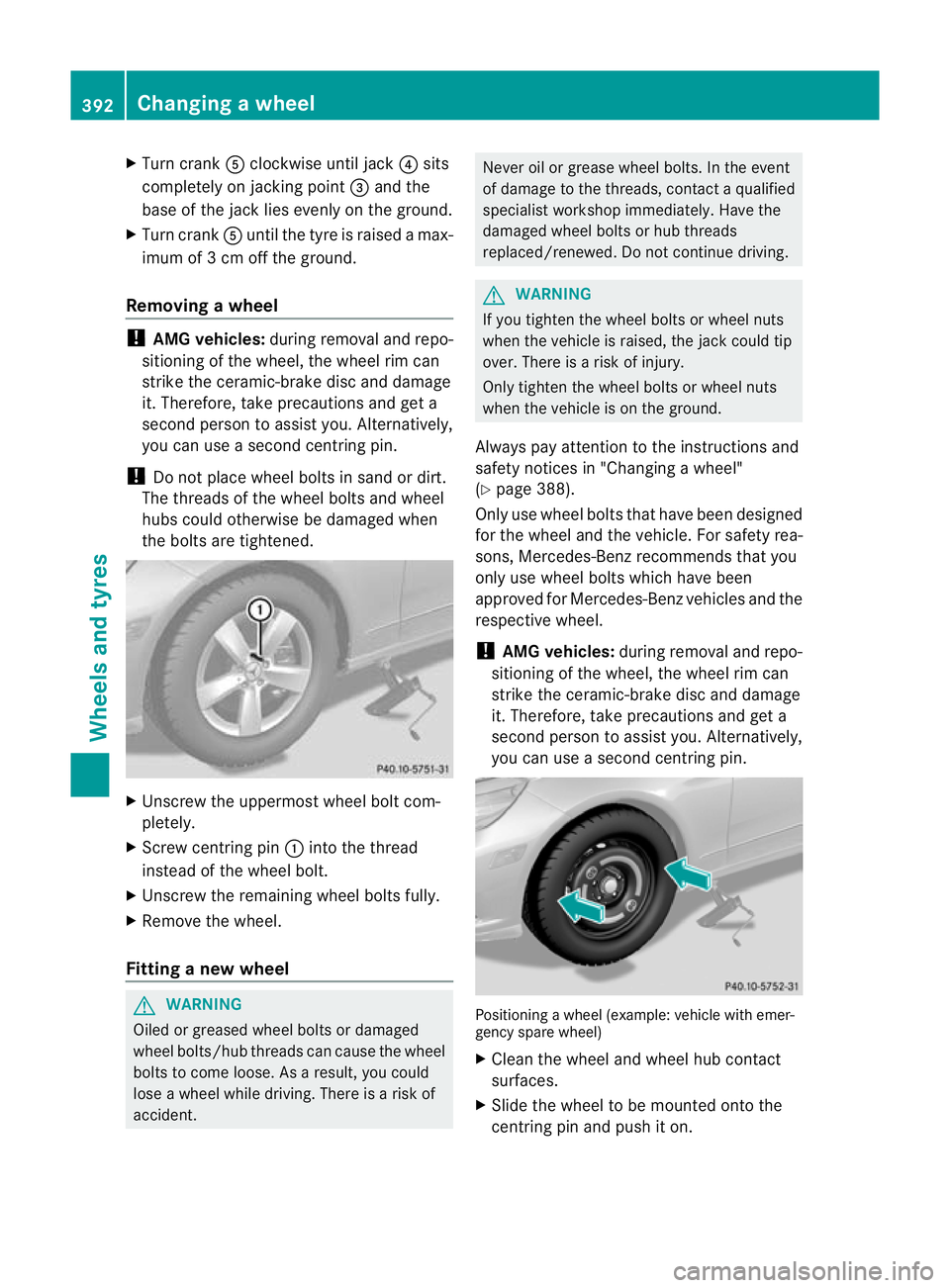
X
Turn crank Aclockwise until jack ?sits
completely on jacking point =and the
base of the jack lies evenly on the ground.
X Turn crank Auntil the tyre is raised a max-
imum of 3 cm off the ground.
Removing awheel !
AMG vehicles: during removal and repo-
sitioning of the wheel, the wheel rim can
strike the ceramic-brake dis cand damage
it. Therefore, take precautions and ge ta
second person to assist you. Alternatively,
you can use a second centring pin.
! Do not place wheel bolts in sand or dirt.
The threads of the wheel bolts and wheel
hubs could otherwise be damaged when
the bolts are tightened. X
Unscrew the uppermost wheel bolt com-
pletely.
X Screw centring pin :into the thread
instead of the wheel bolt.
X Unscrew the remaining wheel bolts fully.
X Remove the wheel.
Fitting anew wheel G
WARNING
Oiled or greased wheel bolts or damaged
wheel bolts/hub threads can cause the wheel
bolts to come loose .As a result, you could
lose a wheel while driving. There is a risk of
accident. Never oil or grease wheel bolts. In the event
of damage to the threads, contact a qualified
specialist workshop immediately.H ave the
damaged wheel bolts or hub threads
replaced/renewed. Do no tcontinue driving. G
WARNING
If you tighten the wheel bolts or wheel nuts
when the vehicle is raised, the jack could tip
over. There is a risk of injury.
Only tighten the wheel bolts or wheel nuts
when the vehicle is on the ground.
Always pay attention to the instructions and
safety notices in "Changing a wheel"
(Y page 388).
Only use wheel bolts that have been designed
for the wheel and the vehicle. For safety rea-
sons, Mercedes-Benz recommends that you
only use wheel bolts which have been
approved for Mercedes-Benz vehicles and the
respective wheel.
! AMG vehicles: during removal and repo-
sitioning of the wheel, the wheel rim can
strike the ceramic-brake disc and damage
it. Therefore, take precautions and get a
second person to assist you. Alternatively,
you can use a second centring pin. Positioning a wheel (example: vehicle with emer-
gency spare wheel)
X
Clean the wheel and wheel hub contact
surfaces.
X Slide the wheel to be mounted onto the
centring pin and push it on. 392
Changing
awheelWheels and tyres
Page 396 of 457
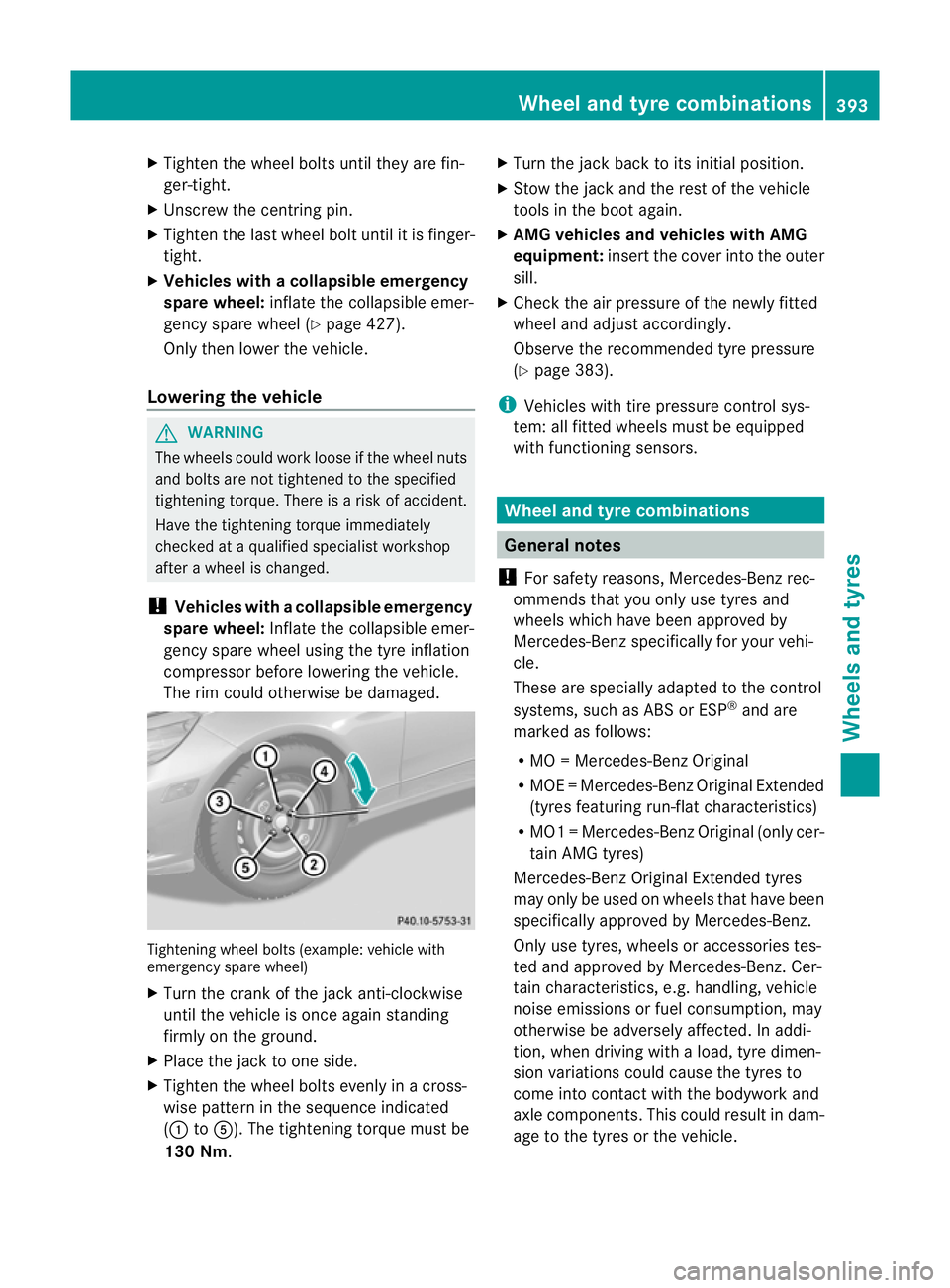
X
Tighten the wheel bolts until they are fin-
ger-tight.
X Unscrew the centring pin.
X Tighten the last wheel bolt until it is finger-
tight.
X Vehicles with acollapsible emergency
spare wheel: inflate the collapsible emer-
gency spare wheel (Y page 427).
Only then lower the vehicle.
Lowering the vehicle G
WARNING
The wheels could work loose if the wheel nuts
and bolts are not tightene dto the specified
tightening torque. There is a risk of accident.
Have the tightening torque immediately
checked at a qualified specialist workshop
after a wheel is changed.
! Vehicles with acollapsible emergency
spare wheel: Inflate the collapsible emer-
gency spare wheel using the tyre inflation
compressor before lowering th evehicle.
The rim could otherwise be damaged. Tightening wheel bolts (example: vehicle with
emergency spare wheel)
X Turn the crank of the jack anti-clockwise
until the vehicle is once again standing
firmly on the ground.
X Place the jack to one side.
X Tighten the wheel bolts evenly in a cross-
wise patter ninthe sequence indicated
(: toA). The tightening torque must be
130 Nm. X
Turn the jack back to its initial position.
X Stow the jack and the rest of the vehicle
tools in the boot again.
X AMG vehicles and vehicles with AMG
equipment: insert the cover into the outer
sill.
X Check the air pressure of the newly fitted
wheel and adjust accordingly.
Observe the recommended tyre pressure
(Y page 383).
i Vehicles with tire pressure control sys-
tem: all fitted wheels must be equipped
with functioning sensors. Wheel and tyre combinations
General notes
! For safety reasons, Mercedes-Ben zrec-
ommends that you only use tyres and
wheels which have been approved by
Mercedes-Benzs pecifically for your vehi-
cle.
These are specially adapted to the control
systems, such as ABS or ESP ®
and are
marked as follows:
R MO =Mercedes-BenzO riginal
R MOE =Mercedes-BenzO riginal Extended
(tyres featuring run-flat characteristics)
R MO1 =Mercedes-BenzO riginal (only cer-
tain AMG tyres)
Mercedes-Benz Original Extended tyres
may only be used on wheels that have been
specifically approved by Mercedes-Benz.
Only use tyres, wheels or accessories tes-
ted and approved by Mercedes-Benz. Cer-
tain characteristics, e.g. handling, vehicle
noise emissions or fuel consumption, may
otherwise be adversely affected. In addi-
tion, when driving with aload, tyre dimen-
sion variations could cause the tyres to
come into contact with the bodywork and
axle components.T his could result in dam-
age to the tyres or the vehicle. Wheel and tyre combinations
393Wheels and tyres Z
Page 397 of 457
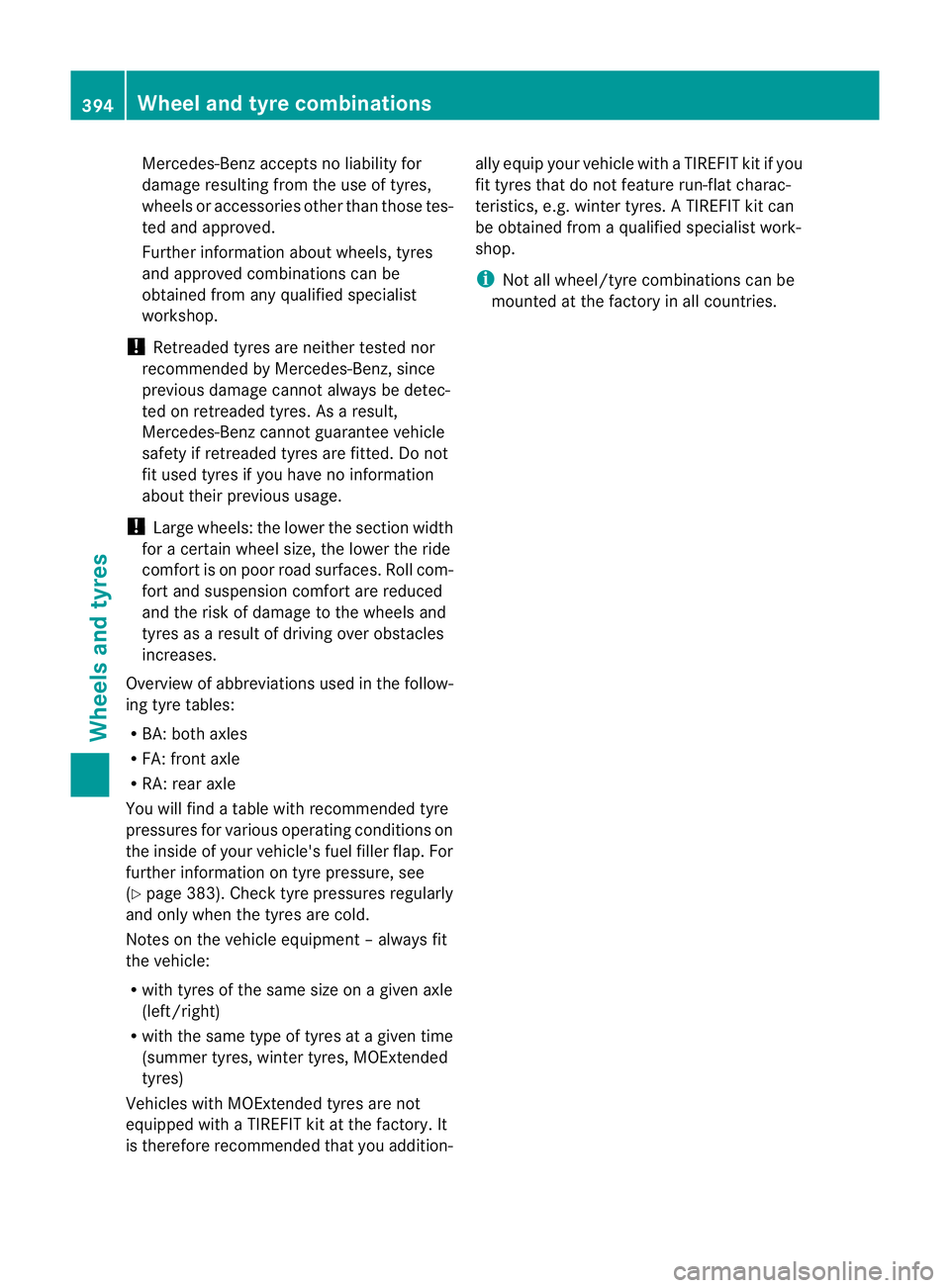
Mercedes-Ben
zaccepts no liability for
damage resulting from the use of tyres,
wheels or accessories othe rthan those tes-
ted and approved.
Further information about wheels, tyres
and approved combinations can be
obtained from any qualified specialist
workshop.
! Retreaded tyres are neither tested nor
recommended by Mercedes-Benz, since
previous damage cannot always be detec-
ted on retreaded tyres. As a result,
Mercedes-Ben zcannot guarantee vehicle
safety if retreaded tyres are fitted. Do not
fit used tyres if you have no information
about their previous usage.
! Large wheels :the lower the section width
for a certain wheel size, the lower the ride
comfort is on poor road surfaces. Roll com-
fort and suspension comfort are reduced
and the risk of damage to the wheels and
tyres as a result of driving over obstacles
increases.
Overview of abbreviations used in the follow-
ing tyre tables:
R BA: both axles
R FA: front axle
R RA: rear axle
You will find a table with recommended tyre
pressures for various operating conditions on
the inside of your vehicle's fuel filler flap. For
further information on tyre pressure, see
(Y page 383). Check tyre pressures regularly
and only when the tyres are cold.
Notes on the vehicle equipment –always fit
the vehicle:
R with tyres of the same size on a given axle
(left/right)
R with the same type of tyres at a given time
(summer tyres, winter tyres, MOExtended
tyres)
Vehicles with MOExtended tyres are not
equipped with a TIREFIT kit at the factory. It
is therefore recommended that you addition- ally equip your vehicle with a TIREFIT kit if you
fit tyres that do not feature run-flat charac-
teristics, e.g. winter tyres. A TIREFIT kit can
be obtained fro
maqualified specialist work-
shop.
i Not all wheel/tyre combinations can be
mounted at the factory in all countries. 394
Wheel and tyre combinationsWheels and tyres
Page 398 of 457
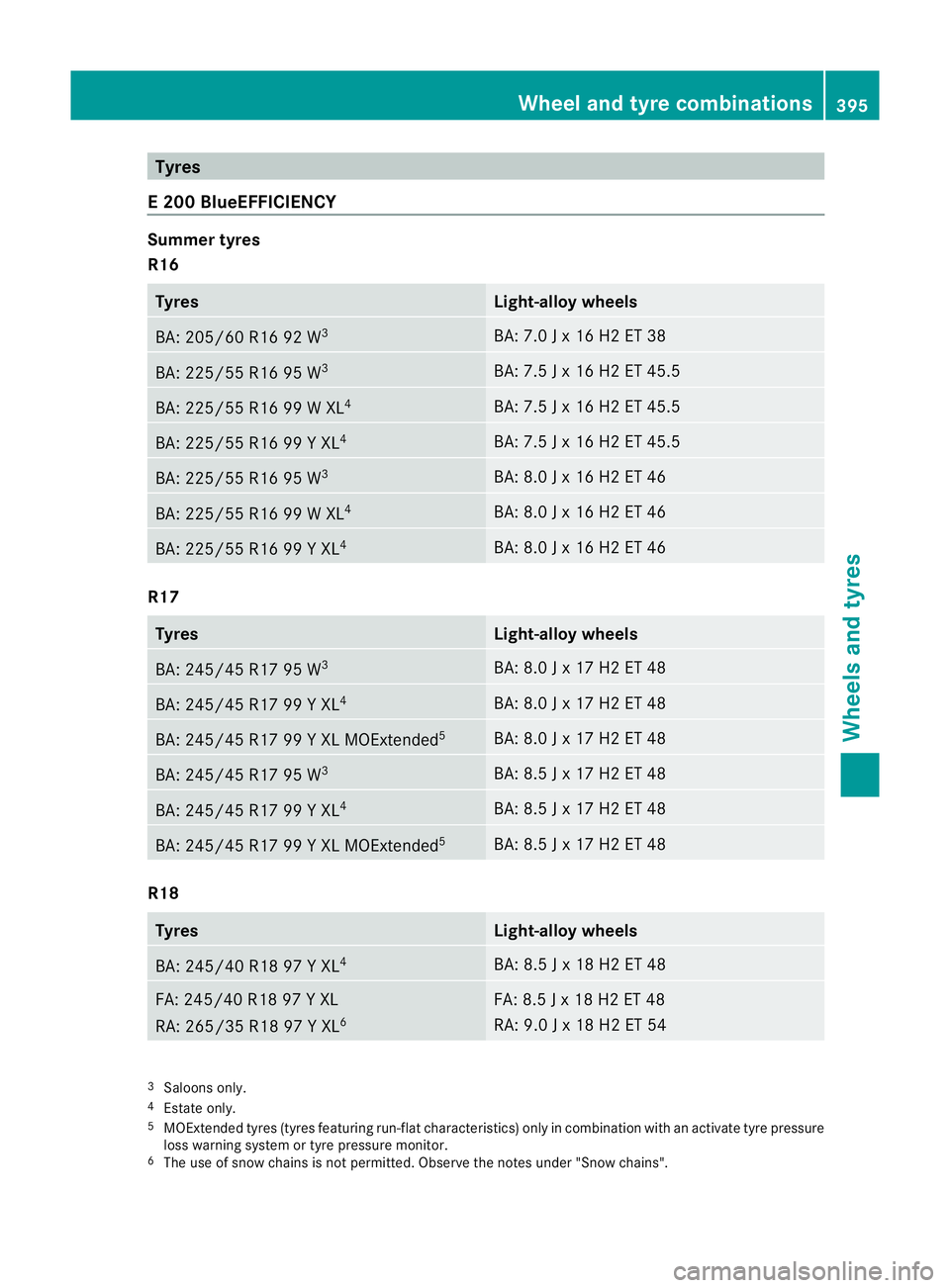
Tyres
E 200 BlueEFFICIENCY Summer tyres
R16
Tyres Light-alloy wheels
BA: 205/6
0 R16 92 W 3 BA: 7.0 J x 16 H2 ET 38
BA: 225/55 R16 95 W
3 BA: 7.5 J x 16 H2 ET 45.5
BA: 225/55 R16 99 W XL
4 BA: 7.5 J x 16 H2 ET 45.5
BA: 225/55 R16 99 Y XL
4 BA: 7.5 J x 16 H2 ET 45.5
BA: 225/55 R16 95 W
3 BA: 8.0 J x 16 H2 ET 46
BA: 225/55 R16 99 W XL
4 BA: 8.0 J x 16 H2 ET 46
BA: 225/55 R16 99 Y XL
4 BA: 8.0 J x 16 H2 ET 46
R17
Tyres Light-allo
ywheels BA: 245/45 R17 95 W
3 BA: 8.0 J x 17 H2 ET 48
BA: 245/45 R17 99 Y XL
4 BA: 8.0 J x 17 H2 ET 48
BA: 245/45 R17 99 Y XL MOExtended
5 BA: 8.0 J x 17 H2 ET 48
BA: 245/45 R17 95 W
3 BA: 8.5 J x 17 H2 ET 48
BA: 245/45 R17 99 Y XL
4 BA: 8.5 J x 17 H2 ET 48
BA: 245/45 R17 99 Y XL MOExtended
5 BA: 8.5 J x 17 H2 ET 48
R18
Tyres Light-alloy wheels
BA: 245/40 R18 97 Y XL
4 BA: 8.5 J x 18 H2 ET 48
FA: 245/40 R18 97 Y XL
RA: 265/35 R18 97 Y XL
6 FA: 8.5 J x 18 H2 ET 48
RA: 9.0 J x 18 H2 ET 54
3
Saloons only.
4 Estate only.
5 MOExtended tyres (tyre sfeaturing run-flat characteristics) only in combination with an activate tyre pressure
loss warning system or tyre pressure monitor.
6 The use of snow chains is not permitted. Observe the notes under "Snow chains". Wheel and tyre combinations
395Wheels and tyres Z
Page 399 of 457
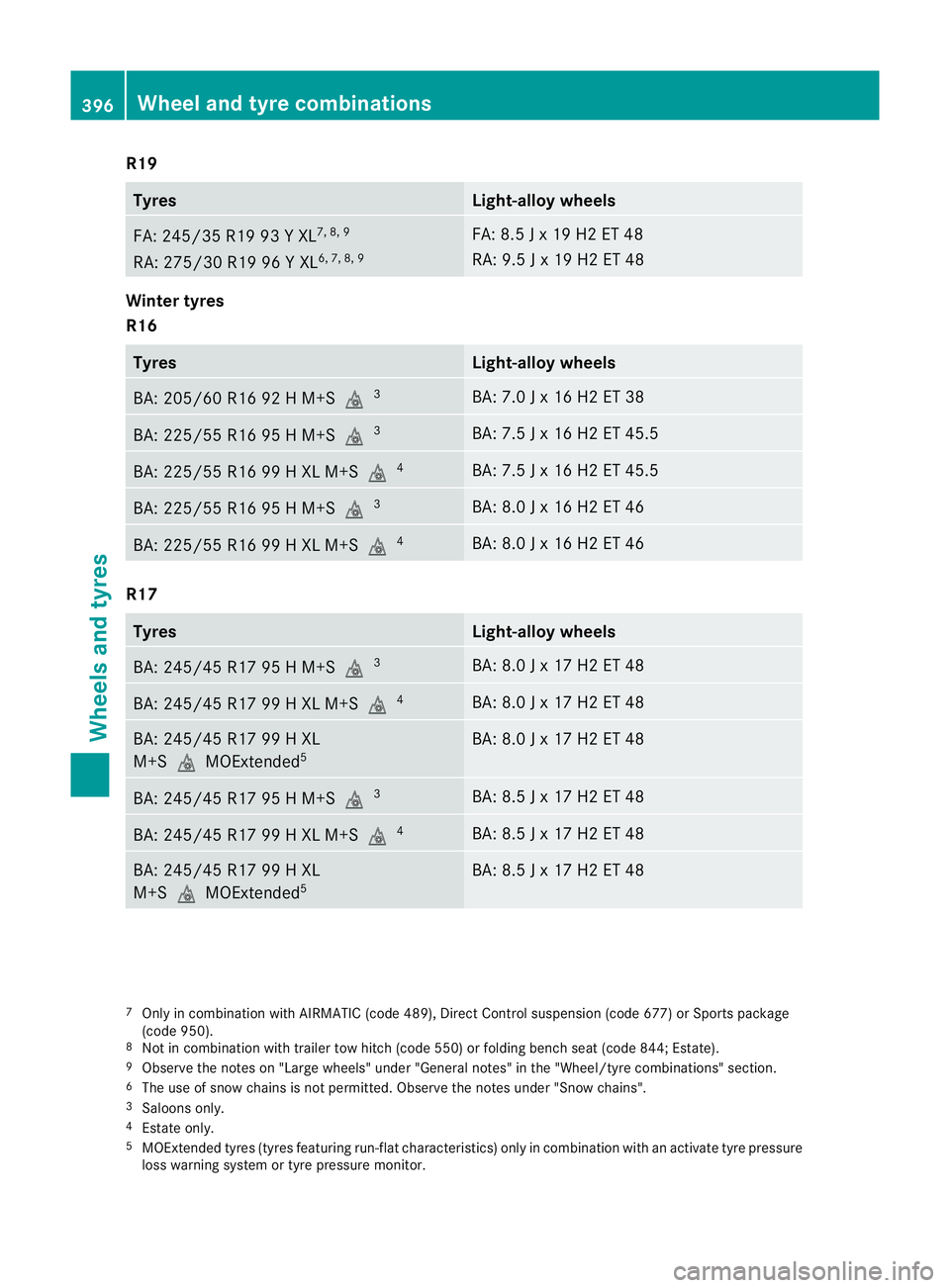
R19
Tyres Light-allo
ywheels FA: 245/35 R19 93 Y XL
7, 8, 9
RA: 275/30 R19 96 Y XL 6, 7, 8, 9 FA: 8.5 J x 19 H2 ET 48
RA: 9.5 J x 19 H2 ET 48
Winter tyres
R16
Tyres Light-alloy wheels
BA: 205/60 R16 92 H M+S
i3 BA: 7.0 J x 16 H2 ET 38
BA: 225/55 R16 95 H M+S
i3 BA: 7.5 J x 16 H2 ET 45.5
BA: 225/55 R16 99 H XL M+S
i4 BA: 7.5 J x 16 H2 ET 45.5
BA: 225/55 R16 95 H M+S
i3 BA: 8.0 J x 16 H2 ET 46
BA: 225/55 R16 99 H XL M+S
i4 BA: 8.0 J x 16 H2 ET 46
R17
Tyres Light-alloy wheels
BA: 245/45 R17 95 H M+S
i3 BA: 8.0 J x 17 H2 ET 48
BA: 245/45 R17 99 H XL M+S
i4 BA: 8.0 J x 17 H2 ET 48
BA: 245/45 R17 99 H XL
M+SiMOExtended
5 BA: 8.0 J x 17 H2 ET 48
BA: 245/45 R17 95 H M+S
i3 BA: 8.5 J x 17 H2 ET 48
BA: 245/45 R17 99 H XL M+S
i4 BA: 8.5 J x 17 H2 ET 48
BA: 245/45 R17 99 H XL
M+SiMOExtended
5 BA: 8.5 J x 17 H2 ET 48
7
Only in combination with AIRMATIC (code 489), Direct Control suspension (code 677) or Sports package
(code 950).
8 Not in combination with trailer tow hitch (code 550) or folding bench seat (code 844; Estate).
9 Observe the notes on "Large wheels" under "General notes" in the "Wheel/tyre combinations" section.
6 The use of snow chains is not permitted. Observe the notes under "Snow chains".
3 Saloons only.
4 Estate only.
5 MOExtended tyres (tyre sfeaturing run-flat characteristics) only in combination with an activate tyre pressure
loss warning system or tyre pressure monitor. 396
Wheel and tyre combinationsWheels and tyres
Page 400 of 457
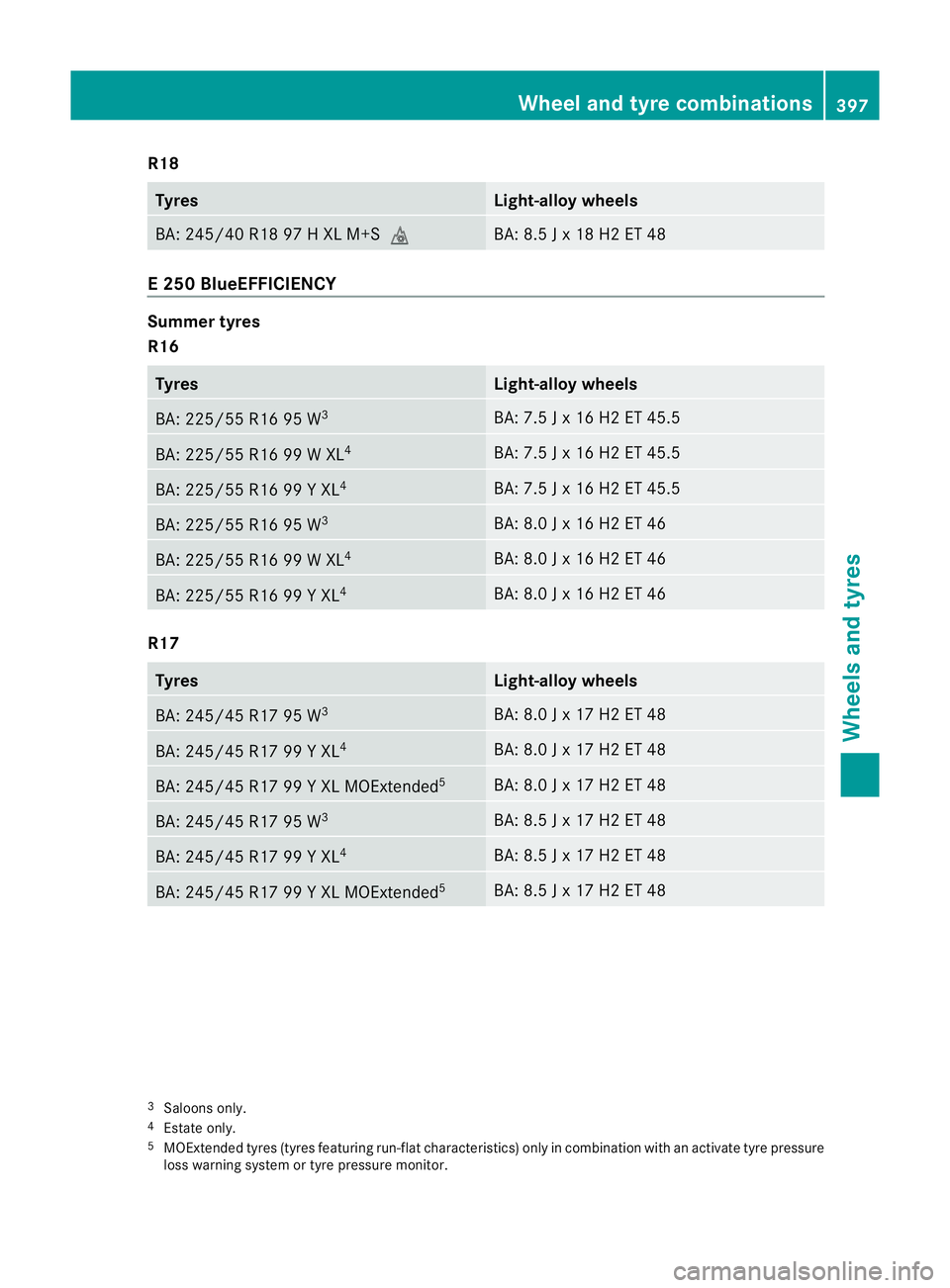
R18
Tyres Light-allo
ywheels BA: 245/40 R18 97 H XL M+S
i BA: 8.5 J x 18 H2 ET 48
E 250 BlueEFFICIENCY
Summer tyres
R16
Tyres Light-alloy wheels
BA: 225/55 R16 95 W
3 BA: 7.5 J x 16 H2 ET 45.5
BA: 225/55 R16 99 W XL
4 BA: 7.5 J x 16 H2 ET 45.5
BA: 225/55 R16 99 Y XL
4 BA: 7.5 J x 16 H2 ET 45.5
BA: 225/55 R16 95 W
3 BA: 8.0 J x 16 H2 ET 46
BA: 225/55 R16 99 W XL
4 BA: 8.0 J x 16 H2 ET 46
BA: 225/55 R16 99 Y XL
4 BA: 8.0 J x 16 H2 ET 46
R17
Tyres Light-alloy wheels
BA: 245/45 R17 95 W
3 BA: 8.0 J x 17 H2 ET 48
BA: 245/45 R17 99 Y XL
4 BA: 8.0 J x 17 H2 ET 48
BA: 245/45 R17 99 Y XL MOExtended
5 BA: 8.0 J x 17 H2 ET 48
BA: 245/45 R17 95 W
3 BA: 8.5 J x 17 H2 ET 48
BA: 245/45 R17 99 Y XL
4 BA: 8.5 J x 17 H2 ET 48
BA: 245/45 R17 99 Y XL MOExtended
5 BA: 8.5 J x 17 H2 ET 48
3
Saloons only.
4 Estate only.
5 MOExtended tyres (tyre sfeaturing run-flat characteristics) only in combination with an activate tyre pressure
loss warning system or tyre pressure monitor. Wheel and tyre combinations
397Wheels and tyres Z